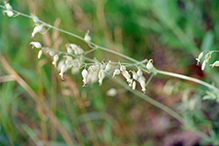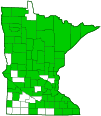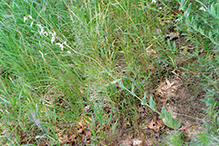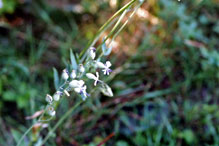Balkan catchfly
(Silene csereii)
Conservation • Description • Habitat • Ecology • Use • Distribution • Taxonomy
Conservation Status |
|
|||||||
| IUCN Red List | not listed |
|||||||
| NatureServe | NNA - Not applicable SNA - Not applicable |
|||||||
| Minnesota | not listed |
|||||||
Description |
||
Balkan catchfly is an erect, up to 40″ tall, annual or biennial forb that rises on several stems from a stout taproot. The stems are bluish-green, erect, and sparingly branched below the inflorescence. They are hairless and are covered with a whitish, somewhat waxy coating (glaucous). When in flower they tend to lean to one side under the weight of the flowers. There are a few thick, glaucous, spatula-shaped basal leaves but these often wither by the time the plant is in bloom. Stem leaves are numerous and in opposite pairs. They are bluish-green, thick, glaucous, and rough to the touch. They are egg- lance-shaped to inversely lance-shaped with the attachment at the narrow end, 1⅛″ to 2¾″ long, ¼″ to 1⅛″ wide. They taper gradually to a pointed tip with straight sides along the tip, and wrap partially around (clasp) the stem at the base. They are attached to the stem without a leaf stalk. The margins are untoothed and have a fringe of hairs near the base. The inflorescence open and has many branches with clusters attached on short stalks or no stalks at all. The main branches are long and raceme-like, the lateral branches short. There are many flowers in the inflorescence. There are 1 to 6 flowers per node. Individual flowers are on stalks that are straight, more or less ascending, and from less than ¼″ to 1⅛″ long. The sepals are fused at the base into a tube (calyx) terminating in short lobes. The calyx is bluish-green, hairless, glaucous, and smooth, not ridged. It is narrowly egg-shaped, slightly inflated, ¼″ to a little over ⅓″ long and about ⅛″ wide when in flower. When in fruit it is narrowly egg-shaped, ⅓″ to ½″ long and up to ¼″ wide. It is constricted at the base and at the opening. There are about 10 long and 10 short, obscure, usually purple-tinged veins with no obvious network of veins between them. The petals are white, with 2 spatula-shaped lobes. They are horizontally spreading, with a stalk-like narrow base (claw) about equaling the calyx in length. They open during daytime. The 10 stamens are 2 times longer than the calyx. The stalks of the stamens that support the anthers (filaments) are purple. The 3 styles are 2 times longer than the calyx. The fruit is a hairless, egg-shaped, 3-chambered capsule the same size as, and tightly enveloped by, the calyx. It has with 6 backward-bending teeth at the top. |
||
Height |
||
Up to 40″ |
||
Flower Color |
||
White, often reddish |
||
Similar Species |
||
Bladder campion (Silene vulgaris) inflorescence is open and much-branched, not long and raceme-like. The calyx is larger and more inflated, and is not constricted at the mouth or base. It has 20 equal veins with an obvious network of veins between them. The stalks of the stamens that support the anthers are not purple. Drummond’s campion (Silene drummondii var. drummondii) has narrow, ⅜″ wide stem leaves. Night-flowering catchfly (Silene noctiflora) flowers open at night. Starry campion (Silene stellata) stems are unbranched. The leaves are in whorls of 4. The petals have 4 to 12 frilly lobes. White campion (Silene latifolia var. alba) stems and leaves are hairy. The stems are covered with minute, short, glandular hairs near the top. The calyx is prominently veined, ridged, and hairy, the veins often accented with purple. Female flowers have 5 styles which project barely beyond the calyx. The flowers open at night. The fruit has 5 upright teeth (appearing as 10) at the top. |
||
Habitat |
||
Dry. Cultivated fields, roadsides, disturbed areas. Full sun. |
||
Ecology |
||
Flowering |
||
May to October |
||
Pests and Diseases |
||
|
||
Use |
||
|
||
Distribution |
||||
|
Sources |
|||
| 2/17/2023 | ||||
Nativity |
||||
Native to Ukraine, Bulgaria, and Romania. Introduced and naturalized in North America. |
||||
Occurrence |
||||
|
||||
Taxonomy |
|||
| Kingdom | Plantae (green algae and land plants) | ||
| Subkingdom | Viridiplantae (green plants) | ||
| Infrakingdom | Streptophyta (land plants and green algae) | ||
| Superdivision | Embryophyta (land plants) | ||
| Division | Tracheophyta (vascular plants) | ||
| Subdivision | Spermatophytina (seed plants) | ||
| Class | Magnoliopsida (flowering plants) | ||
| Subclass | Caryophyllidae | ||
| Superorder | Caryophyllanae | ||
Order |
Caryophyllales (pinks, cactuses, and allies) | ||
Family |
Caryophyllaceae (pink) | ||
| Subfamily | Caryophylloideae | ||
| Tribe | Sileneae | ||
Genus |
Silene (catchflies) | ||
| Subgenus | Behenantha | ||
| Section | Behenantha | ||
Subordinate Taxa |
|||
|
|||
Synonyms |
|||
Silene cserei |
|||
Common Names |
|||
Balkan catchfly biennial campion European catchfly glaucous campion smooth catchfly |
|||
Glossary
Calyx
The flower cup. May be the group of outer floral leaves (sepals) collectively, or a tube with lobes.
Clasping
Describing a leaf that wholly or partly surrounds the stem but does not fuse at the base.
Claw
A stalk-like narrowed base of some petals and sepals.
Filament
The thread-like stalk of a stamen which supports the anther.
Glandular hairs
Hairs spread over aerial vegetation that secrete essential oils. The oils act to protect against herbivores and pathogens or, when on a flower part, attract pollinators. The hairs have a sticky or oily feel.
Glaucous
Pale green or bluish gray due to a whitish, powdery or waxy film, as on a plum or a grape.
Raceme
An unbranched, elongated inflorescence with stalked flowers. The flowers mature from the bottom up.

Slideshows |
||

Visitor Videos |
|||
Share your video of this plant. |
|||
| This button not working for you? Simply email us at info@MinnesotaSeasons.com. Attach a video, a YouTube link, or a cloud storage link. |
|||
Other Videos |
|||

Visitor Sightings |
|||||
Report a sighting of this plant. |
|||||
| This button not working for you? Simply email us at info@MinnesotaSeasons.com. Be sure to include a location. |
|||||
|
|||||
MinnesotaSeasons.com Sightings |
|||||
|
|||||

|
Created: Last Updated: © MinnesotaSeasons.com. All rights reserved. |



